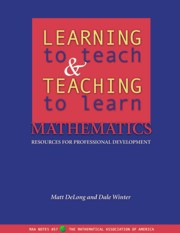Book contents
- Frontmatter
- Preface
- Contents
- 1 The Professional Development Program
- 2 How to Use this Book
- 3 An Orientation Session for the Beginning of the Semester
- 4 Making In-class Groups Work
- 5 Getting Students to Read the Textbook
- 6 Assessing and Evaluating Students' Work
- 7 Managing Homework Teams
- 8 Teaching During Office Hours
- 9 Establishing and Maintaining Control in Your Classroom
- 10 Proctoring Tests and Examinations
- 11 Teaching with Calculators and Computers
- 12 Making Lesson Plans
- 13 Strategies for Motivating Students
- 14 Dealing With Difficult Instructor-Student Situations
- 15 End-of-Semester Administration
- 16 Adapting Materials and Designing Your Own Meetings
- 17 Classroom Visits
- A Tips for Running Meetings
- B The Michigan Introductory Program
- Bibliography
9 - Establishing and Maintaining Control in Your Classroom
- Frontmatter
- Preface
- Contents
- 1 The Professional Development Program
- 2 How to Use this Book
- 3 An Orientation Session for the Beginning of the Semester
- 4 Making In-class Groups Work
- 5 Getting Students to Read the Textbook
- 6 Assessing and Evaluating Students' Work
- 7 Managing Homework Teams
- 8 Teaching During Office Hours
- 9 Establishing and Maintaining Control in Your Classroom
- 10 Proctoring Tests and Examinations
- 11 Teaching with Calculators and Computers
- 12 Making Lesson Plans
- 13 Strategies for Motivating Students
- 14 Dealing With Difficult Instructor-Student Situations
- 15 End-of-Semester Administration
- 16 Adapting Materials and Designing Your Own Meetings
- 17 Classroom Visits
- A Tips for Running Meetings
- B The Michigan Introductory Program
- Bibliography
Summary
The introduction to this chapter is slightly longer than is typical. The idea of this introduction is to provide instructor trainers with a basic idea of what issues may be described under the title of “Control in the Classroom.”
Instructor trainers are usually naturally talented and effective instructors who have a clear vision for what they want to make happen for the students in their class. Likewise, instructor trainers will often have a natural talent for clear communication, and will instinctively take steps to ensure that their classroom is an ideal environment for this communication to take place. As such, instructor trainers may have had little direct, personal experience with classrooms that are out of control. This was certainly the authors' experience when visiting the classrooms of some novice instructors for the first time. We found that in order to help instructors, we needed to reflect on exactly what we understood by “control” in the interactive classroom. The introduction to this chapter presents some ideas of what “control” in a mathematics classroom can mean, and areas where difficulties can arise.
The word “control” evokes a variety of responses from mathematics instructors. Some instructors respond that control is essential—without control over the classroom, students will create so many distractions that no learning is possible. The following short account of such a classroom (related by Steven Krantz [69]) vividly illustrates this possibility.
Information
- Type
- Chapter
- Information
- Learning to Teach and Teaching to Learn MathematicsResources for Professional Development, pp. 115 - 126Publisher: Mathematical Association of AmericaPrint publication year: 2002
